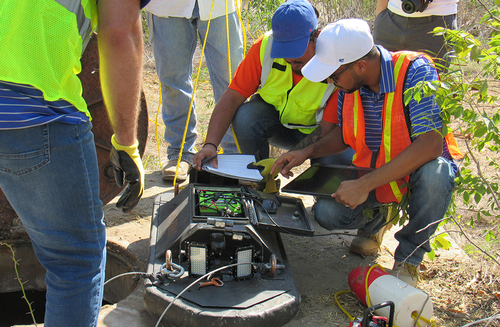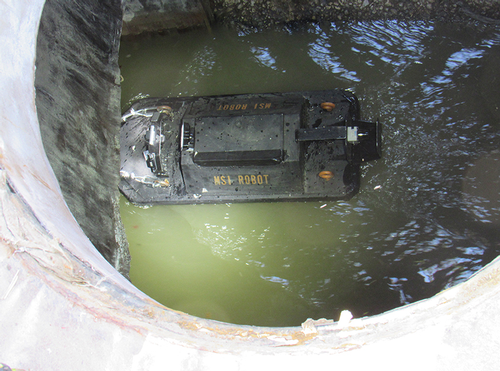WEDNESDAY, DECEMBER 7, 2022
A researcher at Wayne State University wants to use robotics and artificial intelligence work previously utilized in Texas for the inspection of pipelines in Michigan. Led by Dean of Wayne State’s College of Engineering, Ali Abolmaali, the team uses robotic inspection and AI research to determine the remaining service life of pipelines.
Abolmaali, who reportedly arrived from the University of Texas of Arlington, has previously secured more than $38 million in governmental grants and fundraising for his research projects to inspect and predict the remaining service life of existing sewer pipeline systems throughout the Dallas/Fort Worth area.
For the project, he built a robot prototype to inspect wear and tear on pipelines, saving cities millions in repair and maintenance costs.
“We built robots that took us four years to complete in different stages,” said Abolmaali. “Now, our robots are considered to be state-of-the-art in capturing advanced LiDAR and sonar data to be fed into artificial intelligence algorithm developed by my team.
“The robotic inspection capability coupled with artificial intelligence algorithm will form the research enterprise that we are bringing to Wayne State, which will be unique in the nation with no other universities with similar capabilities.”

 |
| Photos: Wayne State University |
|
A researcher at Wayne State University wants to use robotics and artificial intelligence work previously utilized in Texas for the inspection of pipelines in Michigan. |
The research team now uses five robots to inspect pipes with flow (sewer lines) or no flow (gravity or pressure lines) for structural defects and damage. Each robot is equipped with LiDAR, sonar, panoramic 360 video camera and geographic information system used to display data to its location.
Abolmaali said that the LiDAR captures the profile above the fluid line, while the sonar reads data below the fluid line. According to the university, the unmanned, multi-sensor inspection robot enters pipeline systems through a manhole, maneuvering the pipes and providing video views for structural damage data.
“That data is then automatically analyzed by our professional engineer who rates the pipeline based on national specifications,” Abolmaali said. “Once we get that rating, artificial intelligence developed by us will determine the remaining service life of the pipelines.
“The results from analysis may show variations in remaining service life in a stretch of pipeline; for example, the remaining service life of one section of the pipe may be more than 20 years while another section of the pipe may face imminent failure. With this information, cities can prioritize their budget.”
 |
|
According to the university, the unmanned, multi-sensor inspection robot enters pipeline systems through a manhole, maneuvering the pipes and providing video views for structural damage data. |
Abolmaali said that he has a team of 15, led by senior program manager Sara Ridenour, to transfer some projects and secure new projects for Wayne State.
Wayne State reports that Abolmaali has been in contact with the City of Detroit about the pipeline project. He says he welcomes a meeting soon with city officials, as well as the Great Lakes Water Authority, who operate the largest single-site wastewater treatment facility in North America.
Recent Robotics for Inspection
In September, a cleaning and inspection tool development led by Australian energy company Woodside was launched and reportedly offers safe and cost-effective remote inspection of equipment on offshore platforms. The offshore caisson cleaning and inspection tool (CCAIT) system was a collaboration between Woodside and companies Nexxis, Monadelphous, WOMA and Fugro.
According to a release from Nexxis, the one-of-a-kind system utilizes a human-sized robot that is designed to inspect the inside of caissons. These caissons are vertical carbon steel pipes up to 70 meters (about 230 feet) long and up to 1.2 meters wide.
The CCAIT system was reportedly developed in response to possible COVID-related supply chain risks, and was designed, developed and deployed in less than 12 months.
Remotely controlled from a safe location on an offshore platform by skilled technicians, the tool is lowered inside the caisson via a tether and winch arrangement. Wheels are then extended to centralize the tool within the caisson, with probe arms stretched out to enable ultrasound inspection.
High-definition cameras are able to stream video back to the technicians. Then, the technicians use this data alongside the asset team to define a forward plan.
In October, utility company Scottish Water adopted the use of “state-of-the-art” drones and lasers to improve Scotland’s sewers and reduce its carbon emissions.
The company noted that many of its sewers, with some dating back to the Victorian era, have been difficult to access. By deploying these methods, crews are able to see parts of the network that traditional surveying methods can’t reach.
To accomplish this, two operatives utilize drone and Light Detection and Ranging (LiDAR) scanning and measurement systems. This method replaces teams of up to 15 workers, keeping them out of challenging and dangerous underground conditions.
The LiDAR is a laser scanning tool that measures distances, with the associated software creating an accurate computerized 3D point field output that can be viewed on screen. The drone carries this tool and camera onboard as a worker pilots the drone into the pipe for visual inspection and LiDAR measurement.
For the inspections, workers seek to identify issues such as cracks, holes, partial collapses, infiltration and root ingress. The outputs are then manually reviewed by operators to spot and code the defects. The company reports that the systems provide substantially better video quality, defect confirmation and location accuracy compared to traditional techniques.
Later that month, advanced robotics and enterprise software company Gecko Robotics recently entered a collaboration with an energy provider to provide ultrasonic robotic inspection services across Europe.
According to the company's release, these advanced robotic inspections are anticipated to strengthen critical infrastructure and transform how installed equipment is inspected and maintained.
The wall-climbing robots are remote controlled and equipped with ultrasonic transducers, localization sensors, lasers and HD cameras. They can reportedly climb vertically and horizontally, adhering magnetically to an extensive range of equipment types.
These robots can then scan for changes in thickness, cracks, corrosion, blistering, and other forms of degradation. The company reports that the robots include localization technology to pinpoint exact locations on an asset for accurate inspections.
According to the release, data captured by the technology produces a validated report within 24 hours. Then, inspectors can examine corrosion trends over time, predict when failures will occur and estimate when repairs will be necessary.
Tagged categories: Colleges and Universities; Inspection; Inspection equipment; Pipeline; Pipelines; Pipes; Program/Project Management; Quality Control; Research and development; Robotics; Technology; Tools & Equipment